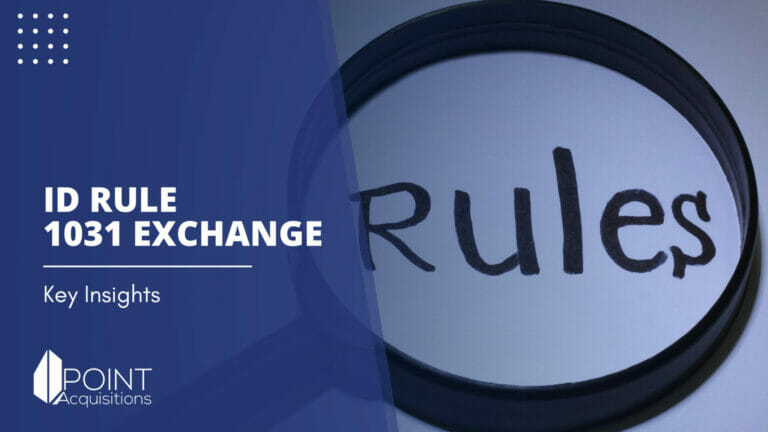
1031 Exchange Identification Rules: Your Key to Commercial Real Estate Success!
If you’re a commercial real estate investor looking to defer capital gains taxes, then you’ve probably heard about the benefits of a 1031 Exchange.
However, to take advantage of this tax-deferral strategy, it’s essential to understand the 1031 exchange identification rules that come with it. In this blog, we’ll explore the key rules to identify replacement properties for a 1031 Exchange.
From the number of potential properties you can identify to the reasonable market value restrictions, we’ll cover everything you need to know to ensure your 1031 Exchange goes smoothly and helps you achieve commercial real estate success. So, let’s dive in!

Table of Contents
Why is it Necessary to Identify Replacement Property?
Identifying replacement properties is a crucial step in a 1031 Exchange because it determines which properties an investor can purchase with the proceeds from the sale of their initial property. In a 1031 Exchange, the investor must reinvest the proceeds into a like-kind property to defer capital gains taxes.
The identification rules set strict guidelines for which properties qualify as like-kind and how many properties an investor can identify. If the investor fails to identify replacement properties within 45 days or identifies properties that do not meet the like-kind requirements, they may face tax liabilities. Therefore, proper identification of replacement properties is necessary to ensure the success of a 1031 Exchange and maximize the tax-deferral benefits.
What Properties Qualify in a 1031 Exchange?
In a 1031 Exchange, the IRS defines the term “like-kind” broadly, which allows for a wide range of properties to qualify for an exchange. Any real property held for investment or used in a trade or business can qualify as a replacement property in a 1031 Exchange. However, there are some restrictions to keep in mind.
The most important rule is that the exchanged properties must be “like-kind.” This means that the sold and the replacement property must be of the same nature or character, even if they differ in grade or quality. For example, an investor can exchange a rental house for a commercial building or vacant land for a shopping center.
However, there are certain types of properties that do not qualify for exchange, such as:
Personal property: Personal property, such as vehicles, art, or collectibles, does not qualify for an exchange.
Property held primarily for resale: Property held primarily for resales, such as inventory or dealer property, does not qualify for an exchange.
Foreign property: Foreign property does not qualify for an exchange.
Partnership interests: Partnership interests do not qualify for an exchange. However, the underlying real estate owned by the partnership may be eligible.
Stocks, bonds, or notes: Stocks, bonds, or notes do not qualify for an exchange.
A wide range of real estate properties can qualify as replacement properties in a 1031 Exchange if they meet the like-kind requirements and are held for investment or used in a trade or business. However, consulting with a qualified intermediary or tax professional is important to ensure IRS rules and regulations compliance.

The Importance of Identifying Replacement Properties in a 1031 Exchange
Identifying replacement properties is a critical step in a 1031 Exchange, as it determines which properties an investor can purchase with the proceeds from the sale of their initial property. The identification rules require the investor to identify potential replacement properties within 45 days of the sale of their initial property, and failing to do so can result in tax liabilities.
Furthermore, the identification rules limit the number of replacement properties an investor can identify and the fair market value of those properties. Failure to comply with these rules can also result in tax liabilities. Therefore, it’s essential to identify potential replacement properties that meet the like-kind requirements and comply with the identification rules to ensure a successful 1031 Exchange.
Proper identification of replacement properties is crucial to achieving commercial real estate success and maximizing the tax-deferral benefits offered by a 1031 Exchange. Identifying suitable replacement properties is also critical to maximize the potential benefits of a 1031 Exchange. By reinvesting the proceeds into a more profitable property, investors can generate greater returns while deferring taxes.
45 Days and Counting
The identification rules of a 1031 Exchange set a strict timeline for investors to identify potential replacement properties. The clock starts ticking when the initial property is sold, and investors have only 45 days to identify potential replacement properties. This deadline is non-negotiable; identifying replacement properties within 45 days can result in tax liabilities.
The 45-day timeline can be challenging for investors needing more time to find suitable replacement properties. To ensure the deadline is met, it’s crucial to start identifying potential replacement properties as soon as possible, preferably before the sale of the initial property.
Investors must also consider the like-kind requirements when identifying potential replacement properties. The replacement property must be like-kind, meaning it must be of the same nature or character as the initial property. For example, an investor cannot exchange a residential property for a commercial property.
In summary, the 45-day identification period is critical to a 1031 Exchange. Investors must plan accordingly to meet the deadline and identify suitable replacement properties that comply with the like-kind requirements. By doing so, investors can defer taxes and reinvest in potentially more profitable properties.

The Dos and Don’ts of Identifying Replacement Properties for a 1031 Exchange
Identifying suitable replacement properties is a crucial aspect of a 1031 Exchange. Investors must follow certain dos and don’ts to ensure a successful exchange.
Dos:
- Start identifying potential replacement properties as soon as possible to meet the 45-day deadline.
- Do consider the like-kind requirements when identifying replacement properties.
- Work with a qualified intermediary to ensure compliance with the 1031 Exchange rules.
- Consider the location, cash flow potential, and future appreciation potential of potential replacement properties.
- Do keep accurate records of the identification and purchase of replacement properties.
Don’ts:
- Don’t miss the 45-day identification deadline, as failure to do so can result in tax liabilities.
- Don’t identify more than three potential replacement properties, as the identification rules limit the number of properties an investor can identify.
- Don’t use the proceeds from the sale of the initial property for personal use, as this can disqualify the exchange.
- Don’t exchange personal property for investment property, as the 1031 Exchange is only available for investment properties.
- Don’t attempt to handle the 1031 Exchange without the assistance of a qualified intermediary or tax professional.
By following these dos and don’ts, investors can ensure a successful 1031 Exchange and take advantage of the tax-deferral benefits offered by this powerful investment strategy.
How to Navigate the Fair Market Value Restrictions in a 1031 Exchange
Navigating the reasonable market value restrictions in a 1031 Exchange can challenge investors. However, there are ways to work within the rules to maximize the tax-deferral benefits of the exchange.
First, it’s essential to understand the fair market value restrictions. The total fair market value of the replacement properties identified cannot exceed 200% of the fair market value of the initial property sold (200% exchange rule). Additionally, investors must acquire replacement properties with a total value equal to or greater than those identified.
To navigate these restrictions, investors can consider identifying properties with a higher fair market value than the initial property sold. By doing so, they can maximize the replacement property’s potential appreciation and rental income while still complying with the reasonable market value restrictions.
Another option is to consider a partial exchange, where the investor reinvests a portion of the proceeds from the sale of the initial property into a replacement property. This can be a useful strategy for investors with difficulty identifying suitable replacement properties that meet the fair market value restrictions.
Working with a qualified intermediary is also essential when navigating the fair market value restrictions in a 1031 Exchange. Intermediaries can provide guidance and expertise to help investors identify suitable replacement properties that comply with the rules.
Navigating the fair market value restrictions in a 1031 Exchange requires careful planning and consideration. By understanding the rules and working with a qualified intermediary, investors can maximize the potential tax-deferral benefits of the exchange and achieve commercial real estate success.

Identifying Up to Three Potential Replacement Properties
The 1031 Exchange rules allow investors to identify up to three potential replacement properties as part of the exchange process. This means that an investor must identify one, two, or three properties they may purchase as replacement properties within the 45-day identification period.
Identifying potential replacement properties can be a challenging task. However, selecting suitable properties that comply with the like-kind requirements and fair market value restrictions is crucial.
Investors must consider several factors when identifying potential replacement properties, including location, rental income potential, future appreciation potential, and any potential tax implications. Working with a qualified intermediary or tax professional can also be beneficial in identifying suitable replacement properties that comply with the 1031 Exchange rules.
It’s important to note that once an investor has identified potential replacement properties, they are bound by these choices and cannot change them after the 45-day identification period. Therefore, it’s crucial to take the time to select the most suitable and profitable replacement properties within the identification period.
The ability to identify up to three potential replacement properties is a key aspect of a 1031 Exchange. By carefully considering the factors mentioned above and working with a qualified intermediary, investors can identify suitable replacement properties that comply with the rules and maximize the potential tax-deferral benefits of the exchange.
Avoiding Common Mistakes When Identifying Replacement Properties in a 1031 Exchange
Identifying replacement properties in a 1031 Exchange can be complex and challenging. Investors must comply with strict rules and regulations, and failure to do so can result in disqualification of the exchange and tax liabilities. To avoid common mistakes when identifying replacement properties in a 1031 Exchange, investors should consider the following:
Start Early: Investors should start the identification process early to ensure they have enough time to research potential replacement properties and complete the exchange within the designated timeframes.
Work with a Qualified Intermediary: A qualified intermediary can provide guidance and expertise to help investors identify suitable replacement properties that comply with the 1031 Exchange rules.
Be Mindful of Deadlines: The identification period is only 45 days, and investors must complete the exchange within 180 days. Investors must be mindful of these deadlines and ensure they have enough time to complete the exchange successfully.
Consider the Fair Market Value Restrictions: The total fair market value of the replacement properties identified cannot exceed 200% of the fair market value of the initial property sold. Investors must consider these restrictions when identifying replacement properties to avoid disqualification.
Focus on Like-Kind Property: Replacement properties must be like-kind to the initial property sold, meaning they must be of the same nature, character, or class. Investors should focus on identifying properties that meet these requirements.
Don’t Forget About Closing Costs: When identifying replacement properties, investors must factor in closing costs and other expenses associated with the purchase. Failure to do so can result in unexpected costs and impact the exchange’s success.
Identifying replacement properties in a 1031 Exchange requires careful planning, consideration, and compliance with the rules and regulations.
By working with a qualified intermediary, being mindful of deadlines, and considering fair market value restrictions and like-kind property, investors can avoid common mistakes and maximize the potential benefits of the exchange.
Conclusion
In conclusion, taxes on commercial real estate sales can be tough; thus a 1031 exchange is a fantastic option to defer capital gains and increase your portfolio of investment properties. identifying replacement properties in a 1031 Exchange is critical to the exchange process. It requires careful planning and consideration.
By adhering to the dos and don’ts, understanding fair market value restrictions, and working with a qualified intermediary or tax professional, investors can successfully navigate the identification process and maximize the tax benefits of the exchange.
If you have questions about or need assistance with your real estate investment strategies, contact us at Point Acquisitions. Our team can guide you in the right direction and connect you with experts who specialize in 1031 exchanges and can provide the guidance and support you need to make informed decisions. Take advantage of the potential benefits of a 1031 exchange and reach out to Point Acquisitions today.
About The Author

Jesse Shemesh
Disclaimer
Please note that Point Acquisitions is not a tax expert or tax advisor. The information on our blogs and pages is for general informational purposes only and should not be relied upon as legal, tax, or accounting advice. Any information provided does not constitute professional advice or create an attorney-client or any other professional relationship. We recommend that you consult with your tax advisor or seek professional advice before making any decisions based on the information provided on our blogs and pages. Point Acquisitions is not responsible for any actions taken based on the information provided on our blogs and pages.
1031 Exchange Capital Gains Tax Deferral
According to a 2021 report by the National Real Estate Exchange Services (RES), over 240,000 1031 exchange transactions were completed in the United States, totaling $100 billion. This impressive figure underscores the role of 1031 exchanges in the real estate…
Read More1031 Exchange Benefits
As of Q4 2023, the national vacancy rate for all commercial property types in the United States sat at 9.2%, according to CBRE’s latest insights and research. This represents a slight decrease compared to the previous quarter and suggests a…
Read More1031 Exchange Legal Considerations: A Must-Read Guide
You’re in the right place if you’re considering a 1031 exchange for your commercial real estate investments. Whether you’re a seasoned investor or just dipping your toes into the market, understanding the legal landscape of 1031 exchanges is key to…
Read More

